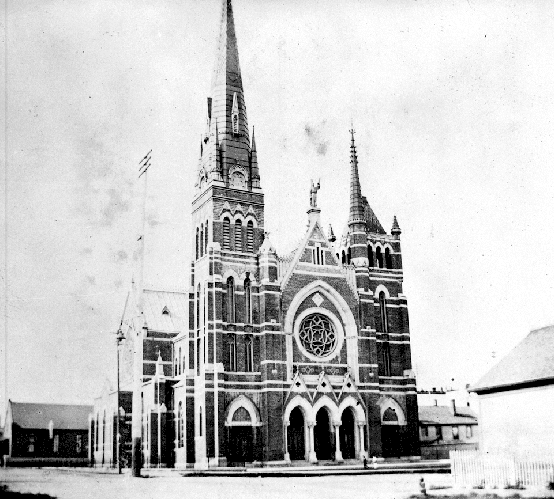St. Andrew's Cathedral
“Bless, O Lord this creature of stone, and grant by the invocation of thy Holy Name, that whosoever with a pure mind, shall give aid to the building of this Church may receive health of body and healing of mind. Through Our Lord, Christ : Amen.” -Right Rev. Bishop Lootens

St. Andrew's Cathedral stands at the corner of View and Blanshard Street.
On Sunday October 5th, 1890, Victoria's Victorian's laid the cornerstone for St. Andrew's Cathedral at its current location. The weather cleared and the skies were blue “ushering in the day whose proceedings are expected to have such an influence on the religious future of the Pacific Coast.” In preparation for the ceremony, the building frame and other signs of construction “that it had been necessary to leave on the ground” were covered or otherwise hidden from view. The equipment used for laying the cornerstone and the skeleton frame of the building was shrouded in decorations suited to a highly religious catholic ceremony. According to the Victoria Daily Colonist: “The character of the service … was impressive alike upon the Protestants and Catholics.”With dimensions of 5x5x3 feet, the cornerstone actually played a structurally integral role to the building. The five and a half ton block came from Keefer's quarry in the Burrard Inlet and bares the name of Reverend Bishop John Nichola Lemmens, who oversaw the project from start to finish. Estimated costs for the construction of the church went upwards from $80,000 in 1890 and only $45,000 of that had been raised at the time of the cornerstone laying ceremony. The Victoria Daily Colonist began covering news of the construction as soon as it was underway, even before the cornerstone was laid and paying special attention to the permanency of the structure.
Lemmens worked with Montreal architects to design a church like one he had seen in Quebec the Church of Longeuil, imitating the European cathedrals of the fourteenth and fifteenth century, while he travelled back and forth between Victoria and Kyuquot Sound, BC. As a missionary, Lemmens worked closely with the indigenous people from Kyuquot Sound to Victoria and in other parts of the country. He was acutely aware of the ruggedness of missionary frontier life and worked cooperatively with other missionaries, settlers, and indigenous people to survive. In his diary, he even talks about Rev. Nicholay working in a saw mill near Kyuquot Sound, when help was needed.
In practice, Rev. Lemmens daily life brought him into contact with labourers and indigenous peoples, but the Victoria Daily Colonist makes no mention of diversity amongst the crowds gathered at the cornerstone ceremony or the opening of the church.
Actually placed inside the cornerstone, the time capsule is a copper manuscript box containing “the names of the Pope, Her Majesty the Queen, and the Governor-General, a list of subscribers names and the amount subscribed up to the present date, specimens of the coinage of the Dominion, and copies of The Colonist and Times containing an account of the proceedings [sic].”
These contents represent the way that Victoria's Victorians wanted to see themselves: emphasizing influence, being able to afford to donate to such an ambitious project; literacy and education; but also as monuments.
The Victoria Daily Colonist referred to Jesus Christ as “the chief cornerstone in all the plans of God” and Lemmens, with the others that paid for the building of St. Andrew's Cathedral felt they were playing an integral part to the planning of the colony.






